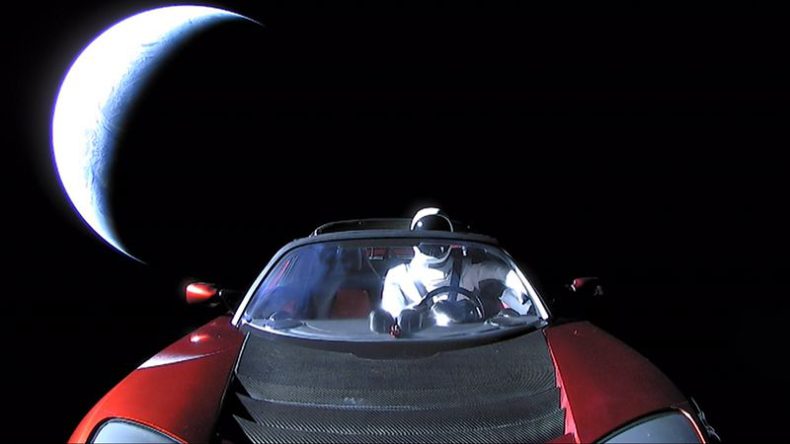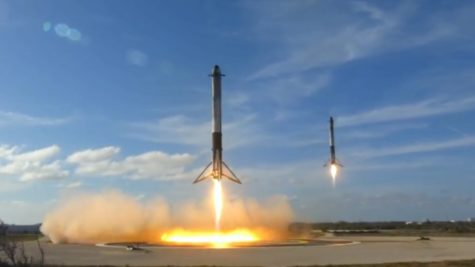
The other day, a giant rocket riding a triple tower of fire lifted a rich guy’s car into space and on to the asteroid belt. You probably heard about this, if you have access to the internet or a newspaper. It was the coolest thing you have seen in a long time, or the most ridiculously wasteful thing you have seen in your life, depending on who you are.
Whether an observer liked or hated it could not be reliably correlated with any particular attribute or affinity. Trump-supporting country-music-listening white male retirees thought it was awesome, or hated it or didn’t care at all. Bleeding-heart progressive socialist David Bowie-listening white women wept with joy, or hated it or didn’t care at all. According to reactions I saw on social media (from the perspective of a white person of privilege), people of color loved it and hated it and laughed at it and also didn’t care at all.
I am more interested in the people who really didn’t like it, because I generally feel uncomfortable when people don’t like things that I like and I want to try and understand them better.
I had lots of conversations and observed several others during the past few days, and I noticed a few common themes. Some people didn’t like it because they thought it was wasteful to throw away a luxury car. Others thought it was disgraceful that the huge rocket didn’t bring up something more useful, more meaningful or more artistic. Plenty of people didn’t like it because they argue we have enough to deal with here on Earth.* Some people were unhappy because they don’t like Elon Musk, who owns the rocket and the car. And some people didn’t like that the car launched on a billionaire’s rocket, painted with a private logo, not a NASA rocket flying the American flag.
The latter argument became more interesting on Sunday, a few days after the Falcon Heavy sent the Tesla toward the asteroid belt, when the Washington Post reported that the Trump administration is considering selling off the International Space Station to a private operator. A lot of people will be very upset about this, too.
The ISS’ future looks uncertain every few budget cycles, so this is far from a sure thing. But the larger message is the same as the Tesla/SpaceX launch: In American spaceflight, especially in low Earth orbit, private companies will be running the show.
SpaceX already sends satellites and cargo into space on the regular, using its tried and true Falcon 9 rockets. For the past year or so, after they loft spy probes or supplies to the ISS, they’ve been executing a diver-style backflip in the upper atmosphere and flying back down. They make their way for a concrete pad or a ship in the ocean, depending on the situation, and they land standing straight up. This is absolutely bonkers, and it is so that they can be used again.

This is a good business decision, because using rockets again is far less wasteful and thereby less expensive than using them once and tossing them into the Atlantic. (It’s also stupidly hard, which is one reason why no one had tried it before.)
Musk has been talking about a bigger rocket, the big enchilada of rockets, a Heavy Lift rocket, for many years. A Heavy Lift rocket can lift a lot more weight, or can send something a lot farther away, than a, uh, regular-lift rocket. The Saturn V, which launched Apollo astronauts to the moon almost 50 years ago, was the most recent Heavy Lift rocket.
Finally, SpaceX built one, by strapping some Falcon 9s together. Finally, after much delay, Musk was ready to launch it. He started talking about it on social media late last year, and then started gleefully teasing the news media, especially the space media who obsessively follow his every tweet. He joked that maybe he’d use it to send his car to Mars. And then it turned out that he meant that last part. What?
To prove the rocket can fly, and not blow up on the launch pad, SpaceX had to load it with something. The short explanation is that an empty rocket does not function in the same way as a rocket carrying a spy satellite, or a probe that will fly to the moons of Saturn. To test it with a realistically heavy payload, SpaceX could have topped the rocket with a concrete block or some other ballast, but instead they chose something more imaginative, and loaded up the boss’s convertible. They added a SpaceX-designed space suit, posed to look like your neighbor lowkey rolling down the street to grab some ice cream. There were some science-fiction-nerd jokes, and yep, David Bowie. It all worked, beautifully.
I agree that a SpaceX rocket heavy with science would have been nice. Many scientists and observers wished Musk would have sent a bunch of research instruments, or children’s science experiments, or hardware that needs to be certified before it can fly on a expensive NASA mission. I do wish the car had carried something like a new mass spectrometer or a new radiation-hardened magnetometer just to test its mettle. That’s such a missed opportunity. It also in no way diminishes my excitement about that launch.
I don’t feel guilty about this excitement, because I am okay with enjoying something I find exhilarating. I am comforted by the knowledge that this will ultimately be good for science. I have come to terms with the fact that we still live in a capitalist country (ad astra, as The Atlantic‘s Marina Koren smartly put it — emphasis on the ad). And, as someone who has followed space exploration since I learned to read, I know science is not always the point anyway.
Absent from most of the heated arguments I watched, or had, last week was a heavy discussion of the geopolitical optics here. Space has always, always been about politics, and this was no different, regardless of whether Elon Musk or Donald Trump sat at the figurative controls. Apollo’s goal — literally, according to the president who announced the program — was to go to the moon because it was hard. We wanted to beat our enemy, the Soviet Union, to the moon. Of course that doesn’t mean the scientific evidence the astronauts toted home was unimportant; it was invaluable. Moon rocks upended astronomy and geophysics, and scientists continue to debate their meaning and their ramifications (and I continue to write about them). Obviously going to the moon was good for science. But science is not why we went.
The fact is that plenty of other countries are angling to do what Musk did last week, and launch massive rockets that can ferry spacecraft into deep space or to Mars. They are also hoping to do what the US government did 50 years ago, and land their astronauts on the moon and take a picture with a rigid version of their flag. They are doing it because it will be meaningful, and hard.
Celebrating SpaceX does not equal supporting Elon Musk as a pitch man for American capitalist democracy — I mean, let’s talk about Tesla’s labor practices first. But a rich guy just sent his beautiful car to weather away in the inky blackness of space, just because he could, and that is one of the more iconically American things I can fathom. I do think that was part of the point. It was performance art. And like most art, any one person’s experience is subjective. It’s great if you think the car was dumb. I don’t agree with you. We can still be friends.
—
Photo credits: SpaceX via YouTube
* There’s an argument to be made that going to space at all is wasteful, and that we have more than enough problems to solve on Earth before we think about leaving it for Mars or the moon. This is a good argument in many ways. Of course we should deal with poverty, and hunger, and injustice, and inequality. We should address that before sending people to “colonize,” or — to use the more hopeful and less exploitative phrase — to explore other places. This has always been true. I am not someone who believes going to space is at cross purposes with these goals. But this isn’t the argument I’m addressing here.
“…and they land standing straight up. This is absolutely bonkers…”
My 25 yo son & I watched the live feed. When this happened, he practically shouted out “Holy shit! We live in the future!”
From my perspective, it was the most positive thing I’ve seen in years.